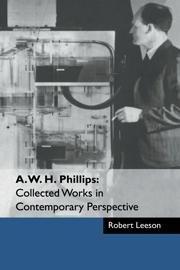Book contents
- Frontmatter
- Contents
- List of contributors
- Foreword by Arthur Brown
- Preface by Robert Leeson
- Part I Bill Phillips: Some Memories and Reflections
- Part II The Phillips Machine
- Part III Dynamic Stabilisation
- Part IV Econometrics
- 36 The Bill Phillips legacy of continuous time modelling and econometric model design
- 37 The published papers
- 38 The influence of A.W. Phillips on econometrics
- 39 An appreciation of A.W. Phillips
- 40 Some notes on the estimation of time-forms of reactions in interdependent dynamic systems
- 41 Cybernetics and the regulation of economic systems
- 42 The estimation of parameters in systems of stochastic differential equations
- 43 Estimation, regulation and prediction in interdependent dynamic systems
- 44 The Walras-Bowley Paper
- 45 Estimation of systems of difference equations with moving average disturbances
- 46 The estimation of continuous time models
- 47 Estimation in continuous time series models with autocorrelated disturbances
- 48 Efficient fitting of rational spectral density functions and transfer functions
- 49 The Lucas Critique: did Phillips make a comparable contribution?
- 50 Models for the control of economic fluctuations
- 51 Statistical estimation for the purpose of economic regulation
- 52 The last paper: a foreshadowing of the Lucas Critique?
- References
- Index of names
- Index of subjects
38 - The influence of A.W. Phillips on econometrics
Published online by Cambridge University Press: 04 May 2010
- Frontmatter
- Contents
- List of contributors
- Foreword by Arthur Brown
- Preface by Robert Leeson
- Part I Bill Phillips: Some Memories and Reflections
- Part II The Phillips Machine
- Part III Dynamic Stabilisation
- Part IV Econometrics
- 36 The Bill Phillips legacy of continuous time modelling and econometric model design
- 37 The published papers
- 38 The influence of A.W. Phillips on econometrics
- 39 An appreciation of A.W. Phillips
- 40 Some notes on the estimation of time-forms of reactions in interdependent dynamic systems
- 41 Cybernetics and the regulation of economic systems
- 42 The estimation of parameters in systems of stochastic differential equations
- 43 Estimation, regulation and prediction in interdependent dynamic systems
- 44 The Walras-Bowley Paper
- 45 Estimation of systems of difference equations with moving average disturbances
- 46 The estimation of continuous time models
- 47 Estimation in continuous time series models with autocorrelated disturbances
- 48 Efficient fitting of rational spectral density functions and transfer functions
- 49 The Lucas Critique: did Phillips make a comparable contribution?
- 50 Models for the control of economic fluctuations
- 51 Statistical estimation for the purpose of economic regulation
- 52 The last paper: a foreshadowing of the Lucas Critique?
- References
- Index of names
- Index of subjects
Summary
Introduction
It is a privilege to contribute to this volume of the Collected Works of A.W.H. ‘Bill’ Phillips. We both knew Bill as a teacher and later colleague, so we commence our chapter with some personal recollections of our first acquaintances. Then we turn to a consideration of the many ways in which Phillips influenced econometrics, focusing on three main aspects (control theory, moving-average errors in dynamic models, and exogeneity).
Personal recollections
Initial contacts
GEM first became aware of Bill Phillips when he visited the Economists' Bookshop following an interview at the LSE for admission to the undergraduate B.Sc.(Econ) degree course. Having previously studied economics from a single textbook in school, he was overwhelmed by the vast array of economics books, arranged not only alphabetically but by subdiscipline. Looking for an inexpensive and less daunting purchase, he came across a section containing very short pamphlets and published versions of public lectures. From this section, he found a copy of an inaugural lecture entitled ‘Employment, Inflation and Growth’ (chapter 22). The combination of subject matter and price attracted him, and so he was soon reading and learning from Bill Phillips. Topics covered in this lecture included discussion of the role of econometric models in economic policy analysis, emphasis on the value of feedback control mechanisms using proportional, derivative and integral controls in economic analysis, and interpretations and modifications to the Phillips Curve (chapter 25), which was to play an important role in macroeconomics during the 1960s and 1970s.
- Type
- Chapter
- Information
- A. W. H. Phillips: Collected Works in Contemporary Perspective , pp. 353 - 364Publisher: Cambridge University PressPrint publication year: 2000
- 7
- Cited by



